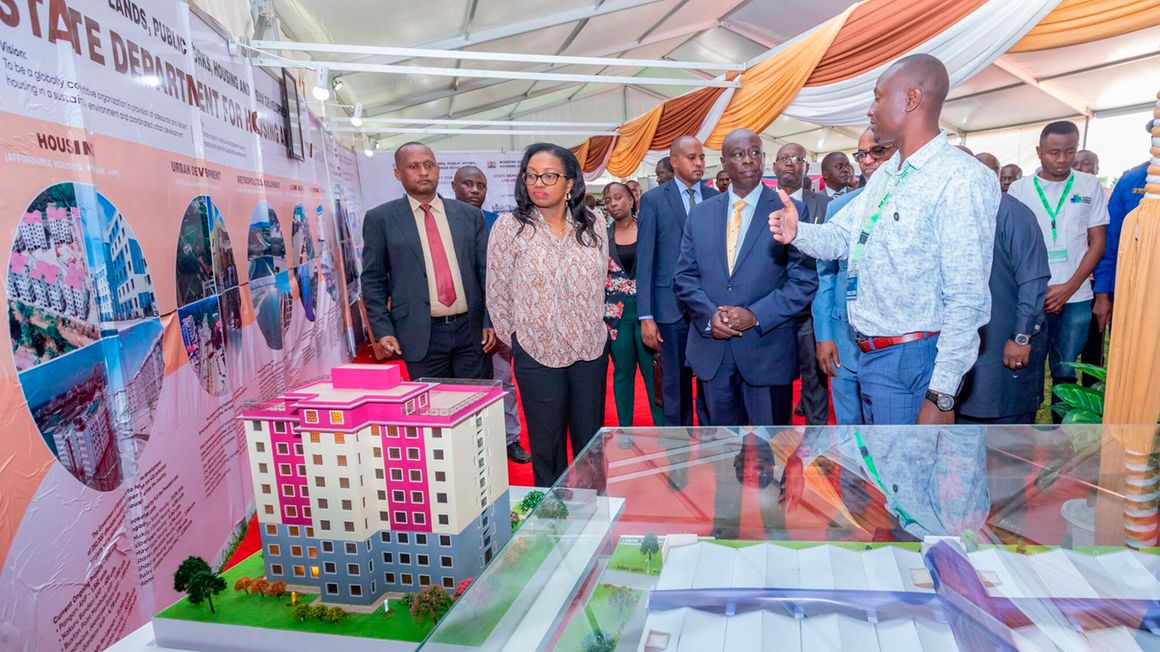
Deputy President Rigathi Gachagua (centre) is shown a housing model during the recent Kenya Urban Forum in Nakuru. PHOTO | DPPS
President William Ruto’s plan to put up decent housing units for low-income earners
has come under sharp focus in the past few weeks. His administration has set a target of about 250,000 low-cost units every year.With average mortgage size in 2022 at Sh9 million at an average interest of 12.3 percent repayable in about 11 years, low- to mid-income workers are locked out of the country’s thin home loans market.
Kenya Mortgage Refinance Company (KMRC), a partnership between the Treasury and privately held lenders, was incorporated in 2020 and tasked with derisking the mortgage market by helping workers with monthly income of Sh150,000 and below access home loans.
Read: KMRC grows cheap home loans four-fold to Sh6.8bn
The firm raises and makes long-term funds available to participating banks, saccos and microfinance institutions for onward lending to prospective homebuyers. The primary lenders get funds at an interest of five percent and are expected to lend customers at single-digit interest with a repayment period of up to 25 years.
Who qualifies for State-backed home loan?
KMRC says any Kenyan, particularly those with what is considered low monthly income, is eligible to apply for the subsidised loan at his or her mortgage provider. Kenyans earning not more than Sh150,000 are considered low-income and qualify for the KMRC-backed loan. Priority is, however, given to first-time home buyers.
What is the process of applying for the home loan under the KMRC framework?
The firm says that the first step for any prospective home owner is to identify a house that he or she can afford using his monthly income. The prospective home buyer should then approach any of the bank or saccos participating in the KMRC plan for a home loan to finance the purchase. Your lender is referred to as primary mortgage provider.
At the moment, commercial banks participating in the KMRC arrangement include KCB, NCBA, Co-operative, Absa, DTB, Stanbic, HF Group and Credit Bank.
Saccos include Stima, Mwalimu, Harambee, Unaitas, Kenya Police, Bingwa, Imarika, Safaricom, Ukulima, Tower and Imarisha.
Kenya Women Microfinance Bank (KWFT) is the sole microfinancier participating in the KMRC home ownership plan.
Can KMRC refinance construction of your house if you have your own land?
KMRC says its financing supports borrowers’ own home construction. In this case, the participating financial institution (bank, sacco or microfinancier) will provide a construction loan that qualifies as a home loan, with an implementation plan and period.
Does KMRC refinance buying of land to build?
The firm says it funds such proposal under its ‘buy and build’ offering.
Does the KMRC mortgage refinancing plan cover those in informal sector?
We didn’t find a product tailor-made for those prospective home buyers with irregular income. KMRC in response says it is facilitating an alternative credit assessment mechanism for people without a regular income to determine their ability to service a mortgage. “This is a way of supporting borrowers in the informal sector to affordably own homes,” the firm says.
What are some of the grounds KMRC will refuse to refinance your home loan?
KMRC says the common cases where refinancing has not been approved involve applicants whose monthly income cannot support repayment of the home loan for the property they have chosen. KMRC funds purchase of houses valued at a maximum of Sh8 million in Nairobi metropolitan area, which extends to Kiambu, Machakos and Kajiado counties, and Sh6 million for homes in the rest of the country.
A prospective home buyer for a Sh5 million property, for example, should be able to repay roughly Sh43,700 monthly for 25 years going by KMRC average interest of 9.5 percent. For a Sh3 million house, she will have to part with about Sh26,300 monthly for the same tenure and interest rate.
A house built on a property that does not conform to the environmental and social impact criteria as approved by the National Environment Management Authority (Nema) would not would not be approved for refinancing as well. These are usually houses on a land in heritage sites, flood prone areas and road reserves. These rules are in line with standards set by the World Bank Group and African Development Bank (AfDB) — the major financiers of KMRC.
How much do you need to raise upfront before you can get a home loan?
This is technically called loan to value (LTV) ratio. Most of the commercial mortgage lenders allow a maximum LTV of 90 percent. This means a prospective buyer has to raise and deposit at least 10 percent of the value of the property to get a home loan.
KMRC, however, says it offers loan to value ratio of up to 105 percent. The amount over and above the value of the property is aimed at enabling the buyer also offset associated expenses such as legal fees and stamp duty.
KMRC chief executive Johnstone Oltetia said: “Some people will want to own a home, but they cannot raise that deposit that is required for purpose of buying that home. So we have removed that rigidity and actually increased LTV to 105 percent, which means five percent above the value [of the house] will be used for those incidental costs that come in. So the bank will give you money for buying the house and also give you money to finance the incidental costs like legal fees and valuation so that there’s no barrier for you to own a house.”
Which houses do KMRC help workers to buy?
KMRC says once a buyer has identified an “affordable home” constructed through a government programme or a private developer, it will provide end user financing to purchase the house.
→cmunda@ke.nationmedia.com

No comments:
Post a Comment